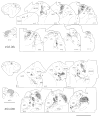Ultrastructural analysis of projections to the pulvinar nucleus of the cat. I: Middle suprasylvian gyrus (areas 5 and 7)
- PMID: 15776451
- PMCID: PMC2562539
- DOI: 10.1002/cne.20480
Ultrastructural analysis of projections to the pulvinar nucleus of the cat. I: Middle suprasylvian gyrus (areas 5 and 7)
Abstract
The mammalian pulvinar nucleus (PUL) establishes heavy interconnections with the parietal lobe, but the precise nature of these connections is only partially understood. To examine the distribution of corticopulvinar cells in the cat, we injected the PUL with retrograde tracers. Corticopulvinar cells were located in layers V and VI of a wide variety of cortical areas, with a major concentration of cells in area 7. To examine the morphology and distribution of corticopulvinar terminals, we injected cortical areas 5 or 7 with anterograde tracers. The majority of corticopulvinar axons were thin fibers (type I) with numerous diffuse small boutons. Thicker (type II) axons with fewer, larger boutons were also present. Boutons of type II axons formed clusters within restricted regions of the PUL. We examined corticopulvinar terminals labeled from area 7 at the ultrastructural level in tissue stained for gamma-aminobutyric acid (GABA). By correlating the size of the presynaptic and postsynaptic profiles, we were able to quantitatively divide the labeled terminals into two categories: small and large (RS and RL, respectively). The RS terminals predominantly innervated small-caliber non-GABAergic (thalamocortical cell) dendrites, whereas the RL terminals established complex synaptic arrangements with dendrites of both GABAergic interneurons and non-GABAergic cells. Interpretation of these results using Sherman and Guillery's recent theories of thalamic organization (Sherman and Guillery [1998] Proc Natl Acad Sci U S A 95:7121-7126) suggests that area 7 may both drive and modulate PUL activity.
Copyright 2005 Wiley-Liss, Inc.
Figures


















References
-
- Abramson BP, Chalupa LM. The laminar distribution of cortical connections with the tecto- and cortico-recipient zones in the cat’s lateral posterior nucleus. Neuroscience. 1985;15:81–95. - PubMed
-
- Amassian VE. Studies on organization of a somesthetic association area including a single unit analysis. J Neurophysiol. 1954;17:39–58. - PubMed
-
- Avendaño C, Stepniewska I, Rausell E, Reinoso-Suárez F. Segregation and heterogeneity of thalamic cell populations projecting to superficial layers of posterior parietal cortex: a retrograde tracer study in cat and monkey. Neuroscience. 1990;39:547–559. - PubMed
-
- Baldauf ZB, Muly EC, Bickford ME. Comparison of posterior cingulate cortex projections to the pulvinar and laterodorsal nuclei. Soc Neurosci Abstr. 2003;68.1
Publication types
MeSH terms
Substances
Grants and funding
LinkOut - more resources
Full Text Sources
Miscellaneous

